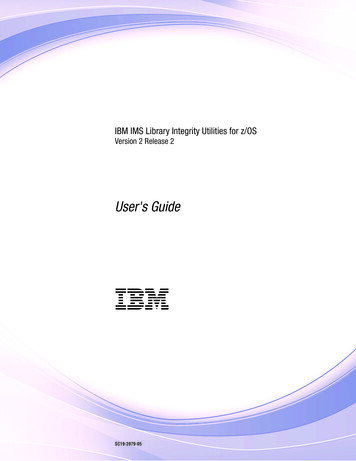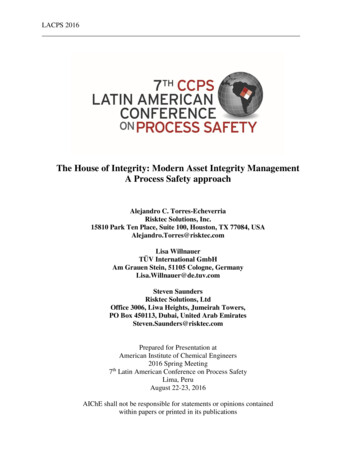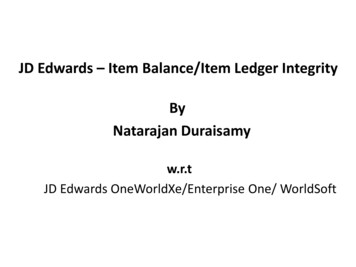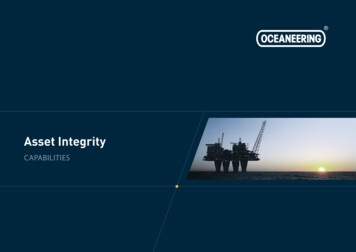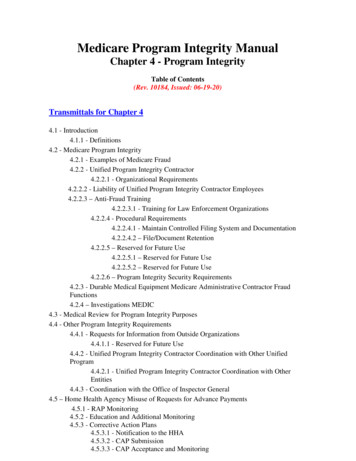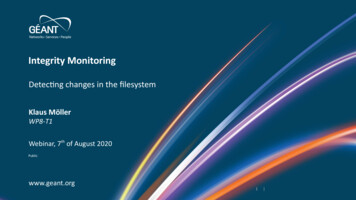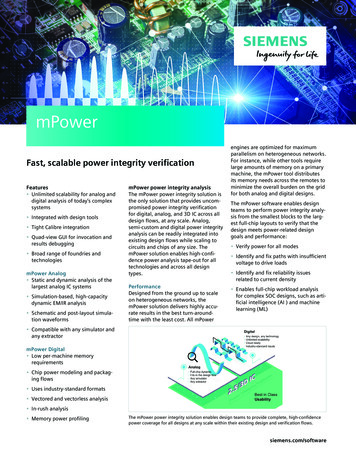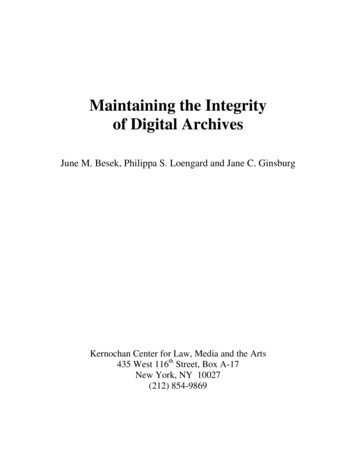
Transcription
Maintaining the Integrityof Digital ArchivesJune M. Besek, Philippa S. Loengard and Jane C. GinsburgKernochan Center for Law, Media and the Arts435 West 116th Street, Box A-17New York, NY 10027(212) 854-9869
MAINTAINING THE INTEGRITY OF DIGITAL ARCHIVESJune M. Besek, Philippa S. Loengard and Jane C. Ginsburg1Table of ContentsAcknowledgementsiiiExecutive Summaryv1.0Introduction12.0Material Removed from Databases and Archives43.0Archives and Digital Archives94.0The Legal Landscape12Copyright Law and Archives LegislationMoral RightsDefamationMistake of FactInvasion of PrivacyCensorshipInternet Service Provider Limitation of LiabilitySummary and Conclusions; International Law Considerations12434655576164655.0How Libraries and Archives Encounter Removal666.0Development of Guidelines to Govern Publisher Retraction and Removal 707.0Libraries’ Contracts with Publishers738.0Digital Archives: Reducing the Risk of Removal809.0Other Challenges to the Integrity of the Scholarly Record8910.0Recommendations90AppendicesApp.-1i
ii
AcknowledgementsWe would also like to acknowledge the many people who generously shared their timeand expertise with us during the course of our study, including Joseph Branin, Ohio StateUniversity Libraries; Beverly Brown, NRC-CISTI; Mimi Calter, Stanford UniversityLibraries; Stephen Chapman, Preservation Librarian for Digital Initiatives, HarvardUniversity Library; Kenneth Crews, Professor of Law and Director, CopyrightManagement Center, IUPUI; Patricia Cruse, California Digital Library; Stephen Davis,Columbia University Library; Thomas Dowling, OhioLINK; Els Van Eijck VanHeslinga, Koninklijke Bibliotheek; Jackie Esposito, Penn State University Archives;Sharon Farb, UCLA; Eileen Fenton, Executive Director, Portico; Kirill Fesenko, CarolinaDigital Library University of North Carolina at Chapel Hill; Martha Fishel, NationalLibrary of Medicine; Dale Flecker, Harvard University Library; Laura Gasaway,Professor of Law, University of North Carolina at Chapel Hill; David Gillikin, Chief,Bibliographic Services Division, NLM: Raimund Goerler, Ohio State UniversityLibraries; Sarah Hill, NRC-CISTI; John Haar, Vanderbilt University Library; PeterHirtle, Intellectual Property Officer, Cornell University Library; Karen Hunter, Elsevier;Carol G. Jenkins, Director Health Sciences Library, University of North Carolina atChapel Hill; Roy Kaufman, Legal Director, John Wiley & Sons; Brewster Kahle,Internet Archive; Nancy Kopans, General Counsel, JSTOR; Tomas A. Lipinski,Associate Professor, School of Information Studies, University of Wisconsin—Milwaukee; Pamela Whiteley McLaughlin, Syracuse University Library; ElizabethMcNamara, partner, Davis Wright Tremaine; Kent McKeever, Director, Arthur W.Diamond Law Library, Columbia Law School; Mary Minow, Esq. (coauthor of TheLibrary’s Legal Answer Book); Samuel Mizer, Brown University Library; James Neal,University Librarian, Columbia University; John Ober, Office of ScholarlyCommunication, University of California; John Ochs, American Chemical Society; AnnOkerson, Associate University Librarian, Yale University; Erik Oltmans, KoninklijkeBibliotheek; Victoria Owen, University of Toronto at Scarborough; Janice T. Pilch,Associate Professor of Library Administration, University of Illinois at UrbanaChampaign; Mary Rasenberger, Library of Congress; Victoria Reich, Director LOCKSSProgram, Stanford University Libraries; Carol Richman, Sage Publications; David S.H.Rosenthal, LOCKSS Program, Stanford University; Richard Rudick, former VP andGeneral Counsel, John Wiley & Sons; Karen Schmidt, University of Illinois at UrbanaChampaign; Jean Shuttleworth, University of Pennsylvania Libraries; Sem Sutter,University of Chicago Library; Barbara Taranto, Digital Library Program, New YorkPublic Library; Brad Vogus, Arizona State University Libraries; Lois Wasoff, former VPand Corporate Counsel, Houghton Mifflin; and Robert Wolven, Columbia UniversityLibrary.Our thanks also to those who helped us in the planning phase, including Joanne Budler,Deputy State Librarian, Michigan; Rebecca Cawley, Statewide Database Administrator,Library of Michigan; Sue Davidsen, Managing Director, Internet Public Library,University of Michigan; Paul Ginsparg, Professor of Physics and Computing andInformation Science, Cornell University (and the creator of ArXiv); David Goodman,Associate Professor, Palmer School of Library and Information Science, Long Islandiii
University; Carol Hutchins, Courant Institute of Mathematical Sciences Library, NewYork University; Rick Lugg, R2 Consulting; Jerome McDonough, Digital LibraryDevelopment, Team Leader, Elmer Bobst Library, New York University; T. ScottPlutchak, Director, Lister Hill Library of Health Sciences, University of Alabama; AbbySmith, Council on Library and Information Resources; Jeffrey Ubois, Internet Archive;Kate Wittenberg, Director, Electronic Publishing Initiative at Columbia (EPIC); and BethYakel, Assistant Professor, School of Information, University of Michiganiv
EXECUTIVE SUMMARYThe goal of this study, sponsored by the Andrew W. Mellon Foundation, was todetermine how digital archives can best structure themselves to avoid the removal ofdocuments from their collections. Archives protect our cultural and intellectual heritage,and removal of materials diminishes the historical record and deprives scholars andresearchers of the opportunity to fully understand past events.Digital technology has provided wonderful new tools for scholarship andresearch, but it also presents challenges for long term preservation. Where libraries oncecollected scholarly journals in hard copy and served as an archive for back issues, theymay now instead have a subscription for online access and rely on the publisher to ensurethe long term availability of those journals. If the material is no longer available from thepublisher, access may effectively be eliminated.This project was prompted by a number of reports in the media of instances inwhich articles were removed from publishers’ databases or from websites. There are anumber of reasons why articles may be removed, including concerns about copyrightinfringement or plagiarism, defamation, privacy rights, factual errors (whether due tomistakes or misconduct), censorship or national security. In some cases publishersremove materials because they no longer own the rights; in others, they do so in responseto user criticism.With the assistance of consultants in five other countries – Australia, Canada,France, Singapore and the United Kingdom – we investigated commonly cited legalbases for removing materials. The laws vary from country to country, sometimes inimportant respects. But in general, libraries and archives have no blanket exemptionsfrom the laws, and are susceptible to some of the same concerns that prompt publishers toremove materials. In some cases, however, due to legal privileges, practical or economicconsiderations, libraries and archives do not have the same risk in making availablematerials that publishers feel compelled to remove. Nevertheless, there are cases inwhich libraries have removed problematic materials from public access.Contracts between publishers and libraries usually permit publishers to removematerial from the “licensed content” that raises legal issues or serious safety concerns.When removal is effected, that material is no longer available on the publisher’s website.We approached this problem in two ways. First, we looked at efforts by publishers andlibraries to keep removals to a minimum through agreements and guidelines. Second, welooked at various types of digital archives developing in response to library concernsabout long term availability of material received pursuant to subscriptions for onlineaccess. We considered how their agreements with publishers address removal, and waysin which they could structure their relationships to avoid removal of works and at thesame time encourage the cooperation and participation of publishers in their endeavors.Our recommendations, the basis for which is discussed in greater detail in thereport, are as follows:v
(1) Encourage the development of not-for-profit third party archives.(2) Encourage the development of standard terminology and best practices for thetreatment of corrections, retractions and removals.(3) Encourage the modification of publisher guidelines that address removals andretractions to include appropriate internal controls, i.e., to require that removal decisionsbe made only by senior editorial staff, and only in consultation with counsel.(4) Archives’ agreements with publishers should narrowly limit the circumstances inwhich publishers can request removal to those in which a publisher has determined, afterconsultation with counsel, that there is a genuine risk of liability or serious harm.(5) Archives’ agreements with publishers should allow the archives to determineindependently whether or not to remove material upon request by the publisher.(6) Archives should create a restricted area, inaccessible to the public, in which tomaintain any material it “removes” based on a publisher’s request or its own liabilityassessment. An archives should not agree to completely remove any material unlessunder direct court order to do so.(7) Material removed from public access should remain listed in the archives catalog,with an appropriate notation.(8) Material in the restricted area of an archives should be reviewed periodically, incooperation with the publisher, to determine whether the circumstances warrantingremoval have changed.(9) Archives and libraries should require publishers to provide notice to them when theyremove articles. Archives’ ingest procedures should provide for an exception reportwhen material is retracted or removed.(10) Any pattern of removals that is detected should be brought to the attention of thepublisher and the scholarly community.(11) The scholarly community should monitor and, where appropriate, participate inlitigation (by means of amicus curiae briefs) and administrative proceedings such asrulemakings that bear on issues relevant to libraries and archives.(12) Concerns about the integrity of digital databases and archives beyond the STMcommunity should be addressed.(13) Certain specific changes in the law should be made, where necessary, to facilitatedigital archiving.vi
a. Libraries and archives qualified for digital preservation should be permitted tocopy and preserve publicly available web content.b. Digital archives should be permitted to take of any legal exceptions generallyapplicable to libraries and archives.c. Libraries and archives qualified for digital preservation should be permitted tomake digital preservation copies of at risk works and maintain them in a securedigital repository.d. Libraries and archives should, with appropriate safeguards, be permitted to useoutside contractors in the performance of their preservation activities.e. Limits on the number of copies that a library and archives may make that aremeaningless in the digital environment should be eliminated, with restrictionsplaced instead on security and the number of access copies that can be madeavailable.(14) Other changes in the law may be necessary in the future, but it may be wiser towait and see where genuine issues arise.We recognize that under exceptional circumstances it may be necessary to limitpublic access to material in a digital archive, or in a publicly available website ordatabase, at least temporarily. However, we hope through our recommendations toencourage practices that will ensure that the scholarly record remains intact.vii
viii
1.0 Introduction1.1 OverviewThe goal of this study, sponsored by the Andrew W. Mellon Foundation, was todetermine how digital archives can best structure themselves to avoid the removal ofdocuments from their collections.2 We began with the general notion that archives arerepositories for documents and other materials that are collected and preserved to ensurethey will remain available for research and study. Historically, archives comprisedphysical materials – publications, letters, diaries, business records – that, once collected,remained in the archives. Archives protect our cultural and intellectual heritage, andremoval of materials from archives diminishes the historical record. Removal alsodeprives users of the opportunity to evaluate independently problematic material and themanner in which it has been addressed in the past.Digital technology has provided wonderful new tools for scholarship andresearch, but it also presents challenges for long term preservation. Where libraries oncecollected scholarly journals in hard copy and served as an archive for back issues, theymay now instead have a subscription for online access and rely on the publisher to ensurethe long term availability of those journals. If the material is no longer available from thepublisher, access may effectively be eliminated.Digital archives are developing to address concerns about the long termavailability of scholarly material. However, they face legal and logistical hurdles incollecting, retaining and making available their collections that traditional archives didnot. Analog preservation is largely passive, and for most works requires interventiononly intermittently. Digital preservation requires regular monitoring to ensure thatcontents are maintained and migrated to new formats as necessary to ensure that theyremain accessible. Best practices for long term preservation of digital materials are stillbeing developed and will likely change over time.This project was prompted by a number of reports in the media of instances inwhich material of value to scholars had been removed from publishers’ databases or fromwebsites. We began by looking at incidents in which publishers removed materials, andthe reasons why. Since potential legal liability was often cited, we looked at the possiblebases for legal liability and how the laws could affect the ability of libraries and archivesto retain and make available materials that publishers removed from their own databases.We considered how digital archives, in the current environment, could structure theirrelationships to avoid removal of works and at the same time encourage the cooperationand participation of publishers in their endeavors.1
There are exceptional circumstances in which it may be necessary to limit publicaccess to material in a digital archive, at least temporarily. However, we hope throughour recommendations to encourage practices that will ensure that the scholarly recordremains intact. Our recommendations relate not only to steps that archives can take toensure the integrity of the scholarly record, but also to measures that can be taken by thescholarly community.We discuss below our approach to this study and the resources we used.Part 2 describes various instances in which material has been removed frompublic access by publishers.Part 3 discusses the concepts of archives in the law, in the library/archivescommunity, and in popular understanding.Part 4 addresses relevant law on copyright, moral rights, defamation, mistake offact, privacy and censorship in the United States, Australia, Canada, France, Singaporeand the United Kingdom.Part 5 discusses circumstances in which libraries encounter removal and retractionof articles, and instances in which libraries themselves have removed materials.Part 6 discusses the development of guidelines to govern retraction and removal.Part 7 addresses relevant provisions of contracts between libraries and publishers,particularly those that relate to publishers’ right to withdraw materials from the licensedcontent, libraries’ right to archive the licensed material, and any rights or obligationsregarding third party archives.Part 8 discusses current examples of digital archives and considers theimplications of different arrangements for legal liability.Part 9 discusses other challenges to the integrity of the scholarly record. Manylibrarians, publishers and others raised concerns about problems other than removal bypublishers, and although these issues are outside the scope of our study, they are worthyof attention.Part 10 describes our recommendations.1.2 Approach and ResourcesIn the initial phase of our project we examined the concept of “archives” inpopular understanding and under the law, the reasons why material is removed fromdatabases and archives, and the way in which archives are treated in copyright law.2
The second phase involved a study of other areas of the law that might affect thedecision of a publisher to remove material from a database or archive, such as tortliability for defamation, mistake of fact, invasion of privacy, censorship, and moral rightsissues, and whether and how archives and libraries may be treated differently frompublishers.We also did extensive factual research (including interviews andcorrespondence with librarians, archivists, legal experts and others) to discover, amongother things, the extent to which libraries have encountered the “vanishing articles”problem, how removal of material is treated in the contracts that libraries and archiveshave with publishers, and whether they perceived other areas where there are gaps in thescholarly record. On the basis of our legal and factual research, we formulatedrecommendations for digital archives. Our primary focus has been on archives ofscholarly material, but our discussion is relevant to other digital archives as well.Digital archives made available over the Internet implicate laws of countries otherthan the United States. In addition to studying U.S. law, we investigated the treatment ofarchives in several other countries, including Australia, Canada, France, the UnitedKingdom and Singapore. We engaged legal consultants in each of these countries. Theyare listed below, with our primary contact for each country first, followed by the namesof others on their research team, where applicable.Australia: Andrew T. Kenyon, Director, CMCL – Center for Media and CommunicationsLaw, University of Melbourne Emily Hudson, Research Fellow, CMCL – Center for Media and CommunicationsLaw and IPRIA – Intellectual Property Research Institute of Australia, Universityof MelbourneCanada: David Lametti, Associate Professor, Faculty of Law, McGill Centre for IP Policy Tara Berish, McGill Centre for IP PolicyFrance: Marie Cornu, Director of Research, CNRS (CECOJI) – Centre d’Etudes sur laCooperation Juridique Internationale (Center for the Study of International LegalCooperation)Singapore: Ng-Loy Wee Loon, Associate Professor, Faculty of Law, National University ofSingapore and Senior Fellow, IP Academy, Singapore Lee Su-Fern, IP Academy, Singapore3
United Kingdom: Lionel Bently, Herchel Smith Professor of Intellectual Property Law, Universityof Cambridge Robert Burrell, Associate Professor in Law, TC Berne School of Law, Universityof Queensland, Australia and Associate Director ACIPA (Australian Centre forIntellectual Property in Agriculture) Paul Mitchell, Reader in Law, King’s College LondonA synthesis of their reports is included below, principally in Section 4.0, andelsewhere as appropriate. The reports in their entirety are included as appendices.2.0 Material Removed from Databases and ArchivesWhile attempts to remove material sometimes occurred in the analog era, it is amatter of increasing concern as digital distribution of journal articles and other materialsbecomes more common. When journals were distributed exclusively in hard copy form,publishers had little ability to make changes once copies left their hands. They mightpublish “errata,” updates or pocket parts, but generally could not compel libraries orarchives to remove materials. Publishers had less incentive to do so then; as they had nocontrol over the use and further distribution of copies they sold, the continuing existenceof the offending material in the archives’ collection was unlikely to increase substantiallythe publishers’ risk of liability.However, the market is changing. Libraries increasingly get access to scholarlyliterature through subscriptions to databases maintained by publishers or aggregators.When the publisher maintains control over the material, as it does in the databasesubscription model, withdrawal of documents may be effected without the participation –indeed, sometimes without the knowledge – of the subscribing institutions. There aremany reasons why material may be removed, as discussed below. Some of thesedeletions likely reflect publishers’ perceptions that the risk of liability in connection withongoing distribution of offending material through a database is significantly greater thanit was with respect to hard copies. Others may reflect business or personal judgmentsabout the propriety of maintaining certain material in databases.Whatever the reason, complete removal of documents has potentially adverseconsequences for scholars and researchers. As columnist William Safire complained, incriticizing Bloomberg News’ decision to withdraw an article that had suggested that arelative of Singapore’s senior minister was appointed to an important position because ofher connections: “I have not read [the] story because it has been expunged from theBloomberg web site, digitally erased from the mind of man.” 3Our research revealed several reasons for removal of articles, examples of whichare described below. Some involve removal of materials not from “digital archives” but4
from websites or databases, and in some cases the material was subsequently restored.Nevertheless, these examples provide insight into why documents might be removedfrom (or might fail to make their way into) a digital archive.1. Copyright infringement/PlagiarismThere is a significant overlap between copyright infringement and plagiarism.4Elsevier has removed several articles from its ScienceDirect database. One sucharticle, by Nikitas Assimakopoulos, was found to have been lifted in large part from abook chapter by another author. The article was removed from ScienceDirect andreplaced by the following notation: “For legal reasons this article has been removed bythe publisher.”5Another set of articles removed from ScienceDirect was co-authored by RichardW. C. Wong and Siu-Yuen Chan and originally published in Elsevier scientific journalsin 2001. Significant portions of the articles apparently had been taken from anotherauthor’s earlier article in Nature Cell Biology.6According to an Elsevier spokesman, the company “has not removed any articlefrom ScienceDirect due to plagiarism,” but instead out of fear of potential liability forcopyright infringement.7In April 2003, users of ArXiv, the popular physics preprint database, noticed astriking similarity between one of Ramy Naboulsi’s articles and the BaBar Physics Book.After it was found that Naboulsi had plagiarized several of his papers, all 22 of hispreprints were withdrawn from ArXiv.8 A search of the database in May 2007 revealedthe citations for the articles and explanations for the withdrawal, but the withdrawnarticles were not available.2. Publisher’s/Database owner’s rights expire or are invalidatedIn New York Times v. Tasini,9 the Supreme Court held that publishers ofcollective works (such as newspapers and magazines) do not have the right to licensearticles by freelance journalists to electronic databases such as Lexis/Nexis, unlessspecifically allowed to do so by contract. As a result of the Supreme Court’s decision,many articles by freelancers have been removed from databases. The Tasini decision,and subsequent developments, are discussed below.3. Defamationa) Denver Journal of International Law and Policy/Boise CascadeIn the spring 1998 issue of Denver Journal of International Law and Policy, twobusiness professors at Boise State University, together with an environmental activist,wrote an article entitled “The Critical Need for Law Reform to Regulate the AbusivePractices of Transnational Corporations: The Illustrative Case of Boise Cascade5
Corporation in Mexico’s Costa Grande and Elsewhere.” The authors argued that certainmultinational corporations, particularly Boise Cascade, had committed “environmentalabuses and had contributed to civil unrest in Mexico.”10 In October 1999 the Universityof Denver withdrew the article and instructed Lexis and Westlaw to terminate onlineaccess to it. According to an errata notice published in the summer 1999 issue of thejournal, the article was “not consistent with the editorial standards” and parts were“clearly inappropriate and require elimination, revision or correction.”11The authors learned of the University’s actions only after they received “ceaseand desist” letters from Boise Cascade demanding that they stop distributing copies of thearticle and stop making false and defamatory statements about the corporation. Theauthors asked the university to reinstate their article. When the university refused, theysued for defamation, claiming the university’s actions breached their contract anddamaged their reputations. The authors prevailed, winning an apology from theuniversity, payment of an undisclosed amount, and the return of the copyright in theirarticle. Whether the university made an independent judgment to retract the article or waspressured by Boise Cascade is a matter of dispute.12b) University of San Francisco Law ReviewProfessor Merle H. Weiner of the University of Oregon wrote an article for theUniversity of San Francisco Law Review on child custody suits under international lawwhere one of the possible homes for the child was potentially unsafe. In the article shemade reference to a particular case under dispute, and one of the parties threatened to sue.Even though she engaged an expert who concluded she had a strong legal defense, herown university would not defend her. The law review, in consultation with counsel at theUniversity of San Francisco, removed the problematic material from her article.13c) University of Rhode IslandDonna Hughes, a professor of women’s studies at the University of Rhode Island,was ordered to remove from her university website two articles she had written oninternational trafficking of women and children. A man and woman that Hughes hadaccused of sex trafficking in one of her articles engaged a London law firm. The firmwrote to Hughes threatening a lawsuit for defamation if she did not remove the articlesfrom her website. She was told by the university’s lawyer that although the case “did nothave merit” the university was concerned about the expense involved in defending it.144. Factual errorsAn independent investigation performed at CNN’s behest resulted in theretraction of a story broadcast on CNN and published in Time magazine. The story,which appeared in Time in June 1998, had claimed that the U.S. military used nerve gasin Laos in 1970.15 The New York Times characterized the retracted article as a“distortion” of the evidence (rather than a fabrication), based on flawed interviewsconsisting of hypothetical questions and vague responses.16 Editors of Time magazine6
and CNN did not remove the story, but instead retracted it.17 (“Withdrawal”, “removal”and “retraction” are not always used the same way in the literature. We will generall use“removal” when an article is no longer accessible to the public and “retraction” when anarticle is repudiated but the article, with an accompanying retraction notice, remainsavailable.)5. Fictionalized accounts/unsupported research or other misconducta) New Republic/Stephen GlassAfter it was discovered that Stephen Glass had fabricated many of the stories hereported for the New Republic, all of his discredited articles were removed from the NewRepublic’s online archives. In a letter to readers, the New Republic explained itsdecision: “When we post something to our archive, it is being continuously published,and that implies ongoing endorsement of its honesty and truthfulness.”18b) Wired News/Philip ChienWired News removed three articles by a freelance space reporter, Philip Chien,from its website when the authenticity of his sources could not be confirmed. One of hissources, a professor of aeronautical engineering, denied having talked to Chien. Anotherof his sources appeared to be fictional; the contact information was an email accountcreated by the reporter.19c) Cincinnati Enquirer/Chiquita BrandsThe editors of the Cincinnati Enquirer removed from the Enquirer’s web archivesapproximately 30 articles concerning an investigation of Chiquita Brands during spring1998.20 The Enquirer’s principal reporter apparently based his articles in part on voicemail messages illegally obtained from a Chiquita employee with access to the company’svoice mail system.21 The Enquirer also paid more than 10 million to Chiquita to settlelegal claims, and issued an apology to the company.22d) Science Magazine/Hwang Woo SukIn late 2005 it was discovered that Dr. Hwang Woo Suk, a South Korean scientistwho claimed to have mastered the technology for cloning human stem cells, had falsifiedhis research. Science magazine, which had published two papers by Dr. Hwang onhuman embryonic stem cell research, issued editorial retractions early in 2006. In lightof the concerns raised by its publication of Dr. Hwang’s papers, the journalcommissioned a special committee to review its practices in connection with the reviewand publication of scientific articles. The committee’s report, the retraction notices andthe original articles are all accessible from a page on Science’s website that describes theincident and the journal’s response.236. Author or customer request (for business or personal concerns)7
Elsevier removed the electronic version of an article published in the September2001 issue of Human Immunology, and also requested libraries to remove the article fromhard copies of the journal. The article app
Champaign; Jean Shuttleworth, University of Pennsylvania Libraries; Sem Sutter, University of Chicago Library; Barbara Taranto, Digital Library Program, New York Public Library; Brad Vogus, Arizona State University Libraries; Lois Wasoff, former VP and Corporate Counsel, Houghton Mifflin; and Robert Wolven, Columbia University Library.


